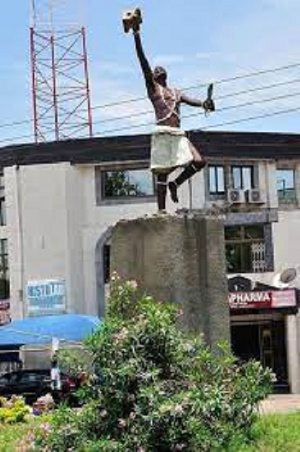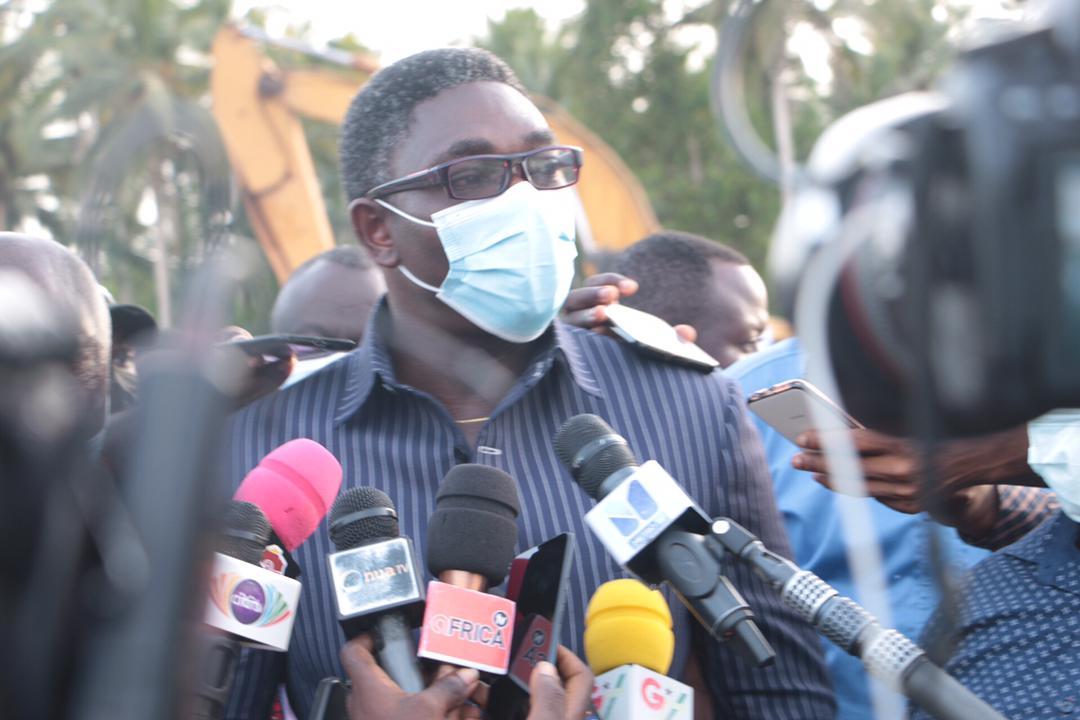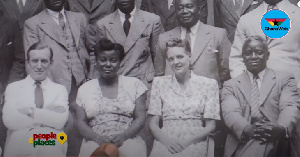All you need to know about Komfo Anokye

Had Asante remained merely a military league the crushing blow of [King] Osei Tutu’s demise would have proved fatal to the Nation. But thanks to the genius of Anokye, as it was a highly organized state it stood strong.
It would be better to compare him with the great American Statesman who determined that the united colonies having successfully asserted their independence of Britain should remain united.
Anokye was a statesman of genius; he succeeded where the Hellenes of old had failed. He brought the people triumphantly through the Liberation War and held them together afterwards.
He was successful because his principles and codes of conduct enshrined in what came to be referred to as The Seventy-Seven Laws of Komfo Anokye were based on a comprehensive knowledge of the long existing customs in the history of the scattered people whom by his genius, he welded into one nation.
He said people would never find the antidote to death as long as they violated its great taboos: funerals and lamentations for the dead. He maintained that death is only death because people persist in making this change ever an occasion for mourning.
He foretold that the Europeans would successfully invade Asante when an Asantehene broke the law.
the ground was strewn with a number of small, perforated pots known as nkosena (small war pots) in which Anokye prepared the war-medicine used to ensure victory against the Denkyira army at Feyiase. Anokye could put liquid in these pots without it running out of the holes. It is said that there were seventy-seven of these vessels, but that they could “come and go,” that is, they could reduce and increase in number.
Anokye drained the Agyempansu and caused it to flow again as the Subin River.
He ensured that the rise and consolidation of the Nation depended on loyalty to a single political and spiritual head, which transcended all tribal or family loyalties.
His descendants serve(d) as Diviners of the Asante Kings.
He endowed the emerging Asante state with a national capital, a national festival, a national army and a flexible constitution.
He introduced a law that made it a capital offence for any Asante citizen to allude to their ancestral origins if that should lead outside Asante.
To achieve the best results, Osei Tutu worked very closely with Komfo Anokye the greatest constitutional advisor of his time.
There are those who are known to possess supernatural powers, but are not necessarily priests of any particular gods. They work directly for the Most High Creator. Anokye was in this category.
He lives in a very fine house with [people] of which they relate nothing but miracles. They affirm that he commands the weather, that he can make it come down soft or hard at his pleasure and drive it out again; that though his house is without any roof, yet it is always sheltered from rain, that he not only knows all things past, but can as accurately foretell all future events as if they were present before his eyes and cures all sorts of distempers.
The meeting of the first Odwira was called in Kumasi by the decree of Komfo Anokye after the fall of Denkyira.
There are many laws and customs encoded in The Seventy-Seven Laws of Komfo Anokye that are common to the Ancient Egyptians and Abyssinians.
Anokye was born at Adansi Akrokyere, Agona Asante
He was an albino born around 1640.
He was born around 1635.
He lived until 1740.
He passed on in 1719 about two to four years after Osei Tutu’s demise.
He lived from 1660 to 1712.
In his old age, Akrofoso became the center of his religious activities.
He prophesied that Asante would remain intact at least through the reigns of the first seven Kings.
He called Siaw Anim in the presence of Osei Tutu and told them about his impending quest for the cure to death.
He advised the King on the constitution in cases involving oaths and fines.
He played an important role in judicial administration.
He never submitted to the forfeiture of what he thought was his by right nor could he be suppressed.
He spat bits of a small chew-stick he had been using to clean his teeth and a tree grew where the pieces fell. This was at Kumasi.
He was said to be a distant relative of Osei Tutu.
He was responsible for the moving of the confederation’s capital from Kwaman to Kumasi.
He was a specialist in fortune telling, character reading, curing barrenness and knowing the medicinal properties of plants.
He negotiated for his own appointment in the Denkyira court [before the formation of the Asante nation]. It was in Denkyira that he first met Komfo Kyirekye who regarded Anokye as a threat. Anokye was accused of seducing a woman and escaped to Awukugua.
He was from the same clan (Agona-Asinie) of the Denkyirahene.
He left Denkyira for Obi-land when his mother was killed in Denkyira on suspicion of witchcraft.
Malicious slander against him caused his departure to the north of Kwaman.
He was excellent at climbing the palm tree using the behema (fiber)-belt.
He was known in Awukugua as Obi Komfo.
When in the latter part of the twentieth century, the “upside-down” palm tree fell, it spun around three times and fell on the exact spot where Anokye used to often stand.
His residence at Agona Asante was called Boboabeduru, and the rock oware game he sculpted with his hands at Awukugua was also named Oboabeduru.
He was regarded as a god in Akyem Abuakwa. There is also an Akyim oath that literally begins with the words, “I swear [Wednesday] Anokye kill me if …”
People who believed they were under a curse or were being haunted by bad luck sought his aid. Those who came to learn about their future left his presence satisfied.
He said the townsfolk that rejected him for speaking against their drinking of polluted water would give birth to bigheaded females with pretty faces.
It was at Abeten (subsequently named Owuoso – the place of death) where a tall palm tree once stood at Agona Asante that he was last seen.
Anokye predicted that Mamponhene Boahene Anantuo would pass away seven days after the Liberation War.
Domaa Kusi had two sisters Afua and Asiedua, both of whom Anokye married before the Third Domaa War. Asiedua gave birth to Agyapa, and Afua to Beresiama.
Before he moved to Agona, he lived at Nkuruoso near Asokore Mampon. This was before Tafo, which was then very powerful town, got involved in the Domaa War.
Anokye in his youth wandered from Asante to Akwapim, visiting Awukugua and Apirede to study therapy, amulets, charms and magic.
He succeeded his brother Yamoa the priest in Obiri Yeboa’s court.
For refusing to forge him an adere (sickle), he damned the smiths of a certain town that they would work hard at the forge but would never become wealthy.
He achieved the amalgamation of the other clans – Bretuo & Asona (Offinso & Edwiso) and Asinie (Amakom), with the Oyoko (Bekwai, Nsuta, Kokofu, Dwaben, Kuntenase) who were already bound to Osei Tutu by blood ties.
Kra Amponsem a Denkyira young man, whom Osei Tutu appointed as his soul washer proved to be an able soldier and was made a Kyidomhene-Commander of the Rear Guard. When Asante captured the Taa Dwemo shrine, Komfo Anokye went into a trance and announced that Osei Tutu should make Kra Amponsem the bosomwura (custodian of the shrine) and entrust him with its resettlement under a certain okoro tree that Anokye pointed out for the shrine’s relocation.
He and Osei Tutu were at Feyiase for the final Liberation War battle.
He prepared war medicine at Nnuroso at Essienimpong to inspire the warriors. At Nnuroso, a sacred orange tree that sprang from the ground when the left-overs of the war medicine that he sprinkled on the combatants poured on the ground, still stands. The fruit of this tree had a lethal effect if it was not eaten under the tree. Anokye’s deeds in Essienimpong are remembered by Asante Kings. Essienimpong chiefs are on this account permitted to shake hands with the Asantehene while still wearing sandals, which is prohibited to most Asante chiefs. Back then, Anokye prohibited any paramount Chief from walking on the soil of the town or seeing the town. Any Omanhene passing through was blindfolded and carried through the street to avoid being blinded. An Edwiso Chief violated this custom and lost his sight instantly. The sons and daughters of Essienimpong are noted for their bravery and quick temper characteristic of Anokye and the effects of the war-medicine.
He and his son Agyapa went to the kyenkyen tree, which he climbed to observe Ntim Gyakari’s camp at Feyiase. His footprints were visible in the trunk of the tree after he had climbed down and left the scene.
He was small in stature with slender limbs, a seemingly delicate physique, but healthy and nimble. From time to time, he withdrew into his farm or other quiet places for inspiration.
The spirit of adventure with which he grew up probably accounted for his capacity to endure hardship and later gave him strength to go into voluntarily exile.
His hair was knotted up in locks.
As a child he was not given to laughter and was not often seen playing with other children. Fun making and jokes irritated him. He was usually witty in asking and answering questions, a characteristic that made the elders marvel. He would sit among elderly people and hold prolonged discussions with them; they were astonished at his command of language as well as his extensive knowledge of tradition.
He would sometimes, as a child, go without food or eat very little for three days or more without suffering any ill effects.
He was reputed to be brave and daring. He was domineering and revengeful, a dangerous and formidable opponent who was sometimes extravagant in his outbursts of temper.
He exhibited practical common sense, rare wisdom and an extraordinary oratorical power height corresponding with that of the fingers on the hand.
He stretched a cow-tail on a river and a crocodile came out of the water.
He hit the ground with his flywhisk and water began to flow from the ground.
He planted a plantain sucker and harvested it the same day.
His sandals drowned in a river, so he “removed” the river’s power to drown any people.
He placed three eggs in the Mampong Valley and this is regarded as the reason why there are no accidents in Gyamaase.
He chewed a kola-nut, spat it to the ground and a white kola nut tree grew from that spot.
The Golden Stool “arrived” in 1697.
He cursed a woman who turned into a river.
All those guilty of not heeding his instructions against his funeral were caught up in the Bonkobuom cave. On festive occasions, mysterious drumming and noises can be heard from inside the cave though no one is seen there.
He laid a pipe on the ground and it turned into a river during the Agona-Dwaben War.
At Agona Akyempem, a mukya (cooking tripod of clay) appears and disappears from time to time. So do earthenware/clay receptacles of liquid.
Goats that passed directly under the drums he had suspended in mid-air lost their lives.
He sat an albino man on a stool, made him disappear and outlawed the sacrificing of albinos from thence.
He decreed that the Esa Nyansen Miensa Firewood would be lit in the Atuotuahene’s palace
Komfo had known the then 36 year old Osei Tutu for 17 years when they came to Asante around 1683 to begin with their nation-building project.
He hand-sculpted another oware game out of rock at Gyaakye.
He cursed the Gyaakye people for seizing his flywhisk and calling him a demon.
At Akutuagya, he caused a palm nut tree with an upward/vertical split in the middle to grow.
He told people that it was possible/there was a way to live forever.
He said the taboos of death included funerals: solemn drumming, gunshots and mourning. Siaw Anim, the caretaker of the stool in Anokye’s absence wanted the stool so badly he chose to flout Komfo’s orders. When his auntie died and Anokye had gone out to bring the cure to death, Siaw Anim organized a funeral.
Some people protested but Siaw and his close friends wept and fired guns. Anokye was returning to Agona by then with the antidote to death. He met a young man from Gyamaase who told Anokye when he asked that it was his sister’s funeral that was being held. He introduced himself, handed the young man his bodua (fly whisk) and asked him to take it to the funeral grounds with a message that it was from Komfo Anokye. The young man protested that they would kill or maim him.
Anokye told him to be confident and go ahead as he would be protected no matter what. So he went there with Anokye’s bodua and delivered the message. The stunned mourners quit their folly and hurried to Atonsu where the young man said he had met Anokye Komfo had disappeared when they got there.
He prophesied that nothing could disrupt the Asante nation’s stability unless the Sword was removed. In 1952, when the constructor of the Komfo Anokye Teaching Hospital, which is located close to the Sword, said he had to remove the Sword to facilitate preparations for the building of the facility, those who knew told him the rationale behind the presence of the Sword. He went ahead and tried to use a bulldozer to remove it. The Sword would dip underground for the bulldozer to pass and resurface afterwards. After about a month of trying, he gave up bewildered. Muhammed Ali the legendary former World Heavyweight Boxing Champion, with permission, attempted to pull it out and failed like all the other strong men who tried.
In 1900, there was an effort to cover the Sword with a cage. Plunderers tried to break this off thinking it was made of gold.
Anokye vanished from this plane of existence with his bodua in hand.
The mystery behind the three eggs at Gyamaase is how they got there. Some think Anokye had something to do with their presence. They have been there over the centuries.
He arrived in Agona without a wife or children though he was about fifty years old.
The Okomfo Anokye Amoampong Stool sat beside Sika Dwa at Otumfuo Opoku Ware II’s funeral.
Anokye’s descendants act “the part” at major Asante ceremonies.
Anokye served as Agonahene in his time. The Agonahene keeps on his sandals when he visits Manhyia Palace.
When Anokye came to Asante, Agona was Kwaman’s ruling clan.
He was held in higher esteem after he created the Agona Amoampong.
He predicted the Domaa War, for which he prepared potions mixed on the Akyawkrom Stool for the warriors. At Suntreso after the war he asked Osei Tutu to establish the Adonten clan.
Asantehene Osei Tutu had to be convinced by Anokye that his ascension to the stool would be worthwhile before they travelled to Asan
He was the Asantehene’s spiritual, economic and constitutional advisor.
It was at Pimpimso that Anokye consecrated Sika Dwa.
Before the Liberation War, Anokye asked, “Who will fight with the fairies or ghosts?” Aduonee Pim volunteered and asked Komfo to inform his brothers. Five Ekuona chiefs, and the Amakom, Akyawkom and the Antoa chiefs joined and fought the war. True to Anokye’s prediction, the ghosts lost the war which was fought at Adunku. They were captured. That was when Anokye created the Adonten Drum from the seven Bofonu trees.
Anokye turned into a stream at Owuoso when he learnt that his funeral was being held.
After establishing the capital, Osei Tutu asked him to choose where he wanted to reside. He chose Agona.
By stander: Ei, this Anokye too, he really tried to challenge God.
Yaw Ben: Who says he challenged God? God gave him those powers. Do you think if
it wasn’t for God, he could have had such powers and accomplished such feats?
Woman at Sword Site: Did he have a mother and a father?
Curator: That’s what some say, but it’s hard to tell.
Kwasi: Was he married?
Sabiru: No. He was like a Spirit.
Points of identification in Asante include Anokye-ko-man-mu.
The Okomfo Anokye Memorial Academy in Awukugua was opened in 1961.
There is an Okomfo Anokye Sacred Grove at Awukugua.
Osei Tutu and Okomfo Anokye built the first African Confederation without using Greece as a reference point.
Anokye encouraged Osei Tutu to create the Poduo (Principal) Stools – the Bantoma, Bantoma Baamu, Adonten and Antoa Poduo Stools.
Safo Pasuampa who had been extremely generous to the King and the Komfo was made the Baamuhene in accordance with Anokye’s will.
Okomfo Anokye made a special sword for Opoku Ware I as a child and made him a ward of Nana Akyia-mmaa, Ohemaa of Pampaso and sister of Nana Agyako Kokoo, Pampasohene. He also planted two spears,one at Pampaso and the other at Asaman, also a ward in Kumasi, to enable him, Komfo Anokye, foretell which of the two spears would yield the successor to King Osei Tutu.
The Pampaso Spear produced a number of small pads (kahyire) by which Komfo Anokye foretold Opoku Ware I as the successor to King Osei Tutu, and the continuity of Pampaso’s essential association with the dynasty. Therefore ever since the installation of Katakyie Opoku Ware I, it is from Pampaso that the final ceremonies and traditional rites of confirming an Asantehene-elect as Asantehene begins. … On arrival, the Asantehene-elect does not greet or speak to anyone but heads directly to Pampafie, the house of Pampasohene.
There he leans three times with his back towards the Piesie Spear planted by Komfo Anokye outside Pampafie. He then enters the house and goes first to the Stool Room.
It has been said that Okomfo Anokye never once existed; And even if he did, he was not the prodigy he is said to have been. To some of these analysts, “his works” should at best be attributed to “acts of nature” and other people’s exertions and accomplishments.
Some analysts have argued that the Golden Stool did not drop from the sky. In their view, Anokye probably commissioned carvers to sculpt it out of wood, after which he had it covered with gold-plate.

His death has been attributed to someone suddenly waking him up while he was astral travelling.
Before the formation of the Asante nation, Anokye traveled for years throughout West Africa learning from the wisdom of old men and priests.
Columnist: Kwasi Anokye





